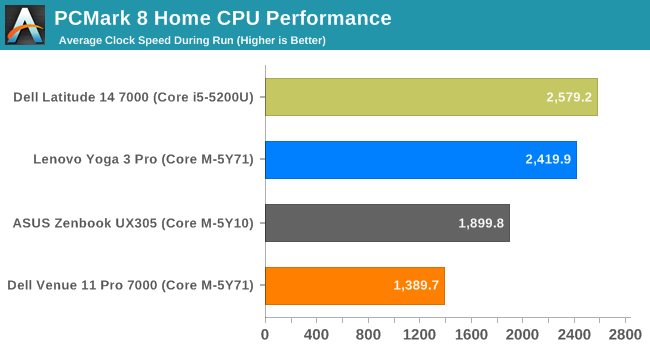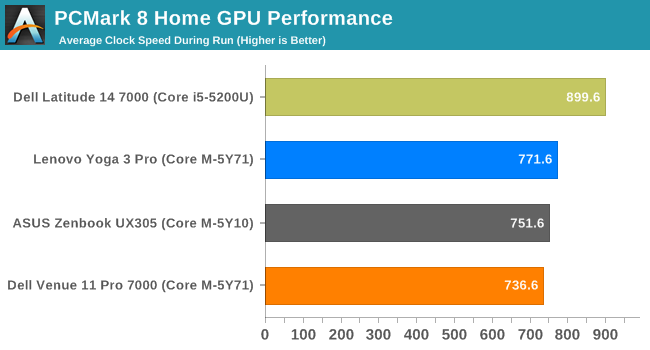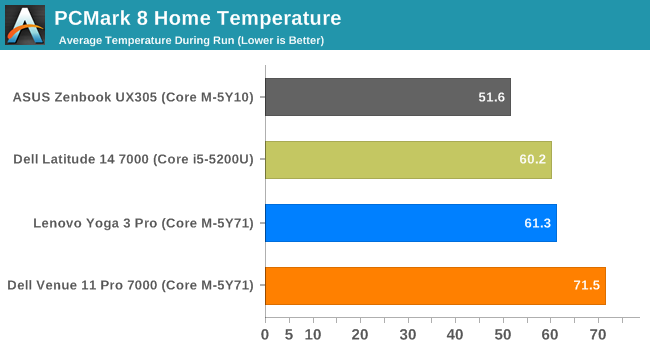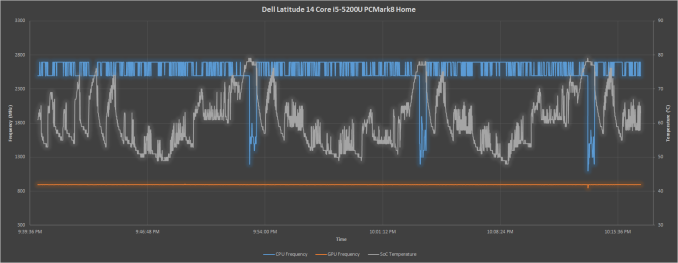Analyzing Intel Core M Performance: How 5Y10 can beat 5Y71 & the OEMs' Dilemma
by Brett Howse & Ian Cutress on April 8, 2015 8:00 AM ESTPCMark 8 Home Results
PCMark 8 Home is a much different workload than Cinebench. Cinebench thrives on sustained performance over the duration of the workload, with the CPU utilization staying around 100% for the duration. While an important metric, most people do not use their computers like that in their day to day lives, so Futuremark has crafted the PCMark suite to perform tasks which are more akin to what the average person will do in a day. Home includes workloads for web browsing, writing, gaming, photo editing, and video chat, and the nature of these loads mean that there is a lot more burst performance needed, so the race to sleep mentality of the Core M can be more effective in this scenario.
The burst nature of this benchmark is apparent just looking at the Core i5. No longer is the CPU frequency consistent across the board, and the temperatures ramp up and down as the work is performed and finished. Even more pronounced is the Dell tablet, which spikes up and down from its maximum temperature, but at the same time ramping clock speeds up quite high as well. The incredible cooling of the ASUS UX305 passive solution makes a big difference here, with the UX305 being able to maintain almost its maximum frequency for the duration of this benchmark. The Yoga 3 Pro really shines here though, with it maintaining quite high speeds for almost the entire duration of the benchmark.

Average CPU frequencies on the other hand show an unexpected disparity between the results we saw above and what the averages end up being. It's the cool Yoga 3 Pro that holds the highest average clockspeeds, followed by the UX305, and finally bringing up the rear is the Venure 11 Pro 7000.

The GPU averages for the three Core M devices are very similar overall, although none are at their maximum. Only the 15 watt Core i5 can maintain its maximum GPU frequency for the duration of this test. As we will see later, GPUs can draw a lot of power.

Moving on to temperature, with the burst nature of this benchmark, all of the devices have a reasonable time to cool off between workloads. The ASUS shows its amazing cooling capabilities again, with a significantly lower temperature than even both of the active cooled devices, but none of them are too close to their maximum allowed temperature over the duration.

Looking at the end result of this benchmark kind of throws everything we have seen in the above graphs on its head. The Yoga 3 Pro, despite sustaining a CPU frequency higher than all of the other Core M devices in this test, ends up scoring the worst, however the overall result by the Yoga 3 Pro is disadvantaged in this benchmark by the gaming test, due to the high resolution display on the Yoga 3 Pro. This is very similar to the results seen in the Dell XPS 13 review, where the QHD+ model only scored 2691 and the FHD model scored 3042 with the same processor. However the ASUS UX305 beats the other Core M devices, although it does so with a much lower resolution display than the Yoga 3 Pro which would certainly beat it otherwise.














110 Comments
View All Comments
serendip - Wednesday, April 8, 2015 - link
Maybe Intel made too many compromises and OEMs reached too far with their designs. On one hand a fast race to sleep is good, yet on the other hand, I'd rather be a slow and steady tortoise who finishes the race than a hare that turbos and sleeps frequently to prevent overheating. Device buyers don't care about TDP or poorly set skin temperature limits, they'll just swear off Core M products that give them throttled 600 MHz speeds instead of full power.boblozano - Wednesday, April 8, 2015 - link
Good point, though I tend to think it'll depend on the use cases. I went back to separate desktop(s) / laptop (rather than a single, uber-laptop) about a year ago. Consequently the laptop can be optimized for size / weight / mobility, for which a core-m device is helpful.jospoortvliet - Thursday, April 9, 2015 - link
Exactly the same here. I will do my video and image editing on my quad-core desktop anyway, so a core M is perfect: I need portability and battery life in a laptop, not raw performance. Intel made just the right chip for a customer like me here. Too bad that on the desktop side, where I would love an affordable six or eight core with a high tdp, they fail me.girishp - Monday, April 13, 2015 - link
I tried doing the same thing, but portability quickly triumphs any advantage of a powerful desktop, especially when a good powerful laptop can do most of what I need. I bought the 2nd gen Mac Book Air for my wife and it was good for her basic multimedia requirements (Photoshop, Final Cut Pro, etc.), but the latest Mac Book just isn't powerful enough for any of her needs.MrSpadge - Wednesday, April 8, 2015 - link
Turbo gives the system increased responsiveness under bursty loads, i.e. most everyday workloads. There's no good reason not to use the performance available and be a tortoise voluntarily. When the load is sustained over longer periods, Turbo automatically throttles back to what ever limit the OEM has set. Had you choosen the tortoise mode, you would have started at this point. With Turbo you don't loose any performance compared to this scenario, it just makes you reach the limit quicker. Turbo also autoamtically factors in things like "how many cores are loaded", "how stresful is this program in reality", "how good is the device cooling" and "how hot is the ambient" by simply measuring them empirically (power consumption & temperature). In fixed tortoise mode you'd have to predict all of them and assume the worst case, just like Intel & AMD did for the first dual and quad cores with low fixed frequencies.If Turbo results in "turbos and sleeps frequently to prevent overheating" it is simply set up badly, significantly worse than Turbo on Intel Desktop CPUs since a few years. Instead of sleeping to avoid overheating the turbo bin must gradually be lowered until a good steady state is reached.
MrSpadge - Wednesday, April 8, 2015 - link
Forgot to add: it would be really nice if there was a simple user control for their current preference of maximum performance vs. tolerated temperature. Win allows limiting a CPUs maximum performance state, but most users will never find this option in the advanced energy settings. A simple slider as a sidebar-like gadget could work well. Not only for Core-M, but also for regular laptops and desktops. Add one slider for each discrete GPU's power target.mkozakewich - Wednesday, April 8, 2015 - link
Also, MS removed that option in all their PCs with connected standby. You can still enable it through the registry, but regular users are even less likely to make use of that option. We need some sane defaults set so we can have separate "Low Power", "Balanced" and "Overdrive" modes. We won't care about skin temperature if we've chosen to use that temperature briefly and we have an option to turn it back down.soccerballtux - Wednesday, April 8, 2015 - link
the biggest problem is Windows packaging in tons of storage indexing that runs every time you log in, or letting services run around in the background and datamine (Facebook, Amazon Music re-scans every 10 minutes-- I mean seriously? might as sell me a phone with 100MB less of RAM if you're going to do that)The_Assimilator - Wednesday, April 8, 2015 - link
Because it's obviously Windows' fault that it runs services that you told it to install.lilmoe - Thursday, April 9, 2015 - link
+1